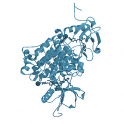
- Remove this product from my favorite's list.
- Add this product to my list of favorites.
Products
Newsletter
 |  |  |  |  |  |

Background: Abl1 belongs to the family of the non-receptor tyrosine kinases. The protein is ubiquitously expressed in cells of various tissues at the cytoplasmic as well as nuclear level and is involved in the regulation of cell growth, survival and morphogenesis. Abl proteins show a modular organization, similar to that of members of the Src family, and are characterized by an N-terminus followed by a Src homology 3 (SH3) domain, a SH2 domain and the catalytic core. By intramolecular interactions Abl1 is kept in a closed and inactive conformation. Activation occurs upon interaction with SH3- and/or SH2-binders, which induces an opening of the structure. Deregulated Abl1 is involved in cancer. The translocation of ABL1 to the BCR gene, generating the Bcr/Abl fusion, the so called Philadelphia (Ph)-chromosome, results in a constitutive active tyrosine-kinase which is strongly associated with chronic myeloid leukemia (CML).
Protein: Human recombinant ABL1, amino acids P118-S535 (as in GenBank entry M14752), N-terminally fused to
GST tag with a 3C cleavage site
Theoretical MW (Abl1): 76.2 kDa (fusion protein)
Expression system: Baculovirus infected Sf9 cells
Purification: One-step affinity purification using glutathione agarose
Storage buffer: 50 mM Hepes, pH 7.5; 100 mM NaCl, 5 mM DTT, 15 mM reduced glutathione, 20% glycerol
Storage temperature: - 80°C (avoid repeated freeze-thaw cycles !)
Protein concentration: 0.414 mg/ml (Bradford method using BSA as standard protein)
Method for determination of Km value & specific activity: Filter binding assay MAFC membrane
Specific activity: 75,.000 pmol/mg min
Entrez Gene ID: 25
UniProtKB: P00519
Ordering information: shipped on dry ice
Saglio G, Cilloni D. (2004) " Abl: the prototype of oncogenic fusion proteins." Cell Mol Life Sci. 61(23):2897-911.
Sirvent A, Benistant C, Roche S. (2008) "Cytoplasmic signalling by the c-Abl tyrosine kinase in normal and cancer cells." Biol Cell. 100(11):617-31.
Wang JY. (1993) "Abl tyrosine kinase in signal transduction and cell-cycle regulation." Curr Opin Genet Dev. 3(1):35-43.
Chen H, Adams E, Van Schepdael A. (2013) "Study of Abl1 tyrosine kinase inhibitors by liquid chromatography-electrospray ionization-mass spectrometry." Talanta. 2013 Mar 30;107:88-94.
Chen H, Wang X, Chopra S, Adams E, Van Schepdael A. (2014) "Development and validation of an indirect pulsed electrochemical detection method for monitoring the inhibition of Abl1 tyrosine kinase." J Pharm Biomed Anal. 90:52-7.
Hui ChenIrene Garrido AriasErwin AdamsAnn Van Schepdae (2016) "HPLC-UV Method for Determining Phosphorylated Peptide and for Abl1 Tyrosine Kinase Inhibition Study" Chromatographia, 77, 3–4, 241–247.
Welcome Login
Contact us
Follow us